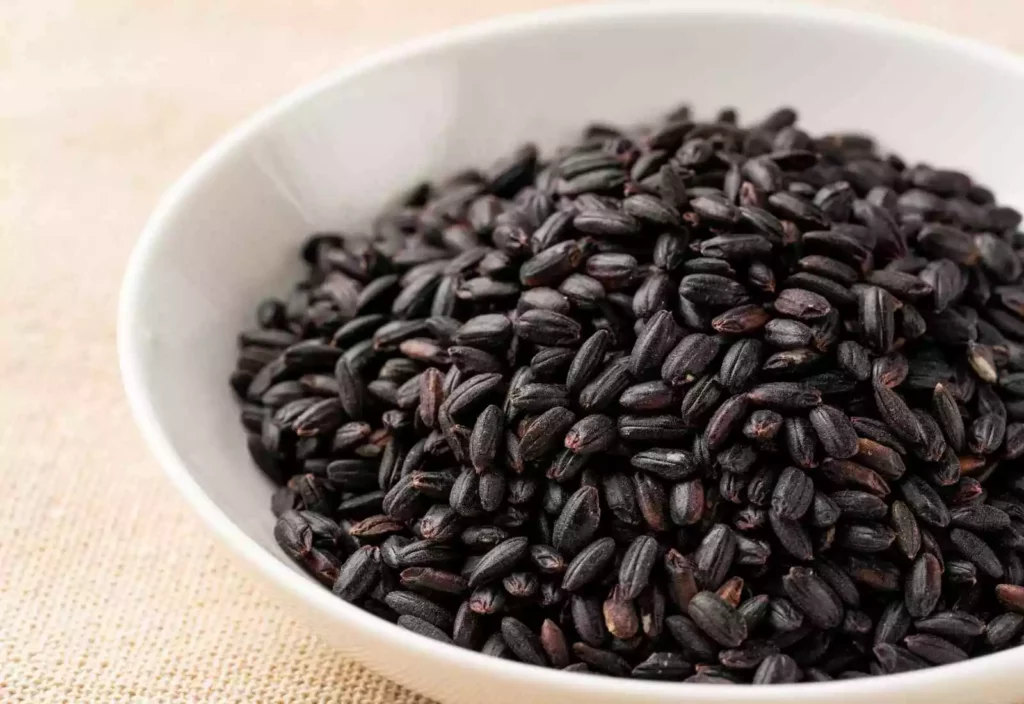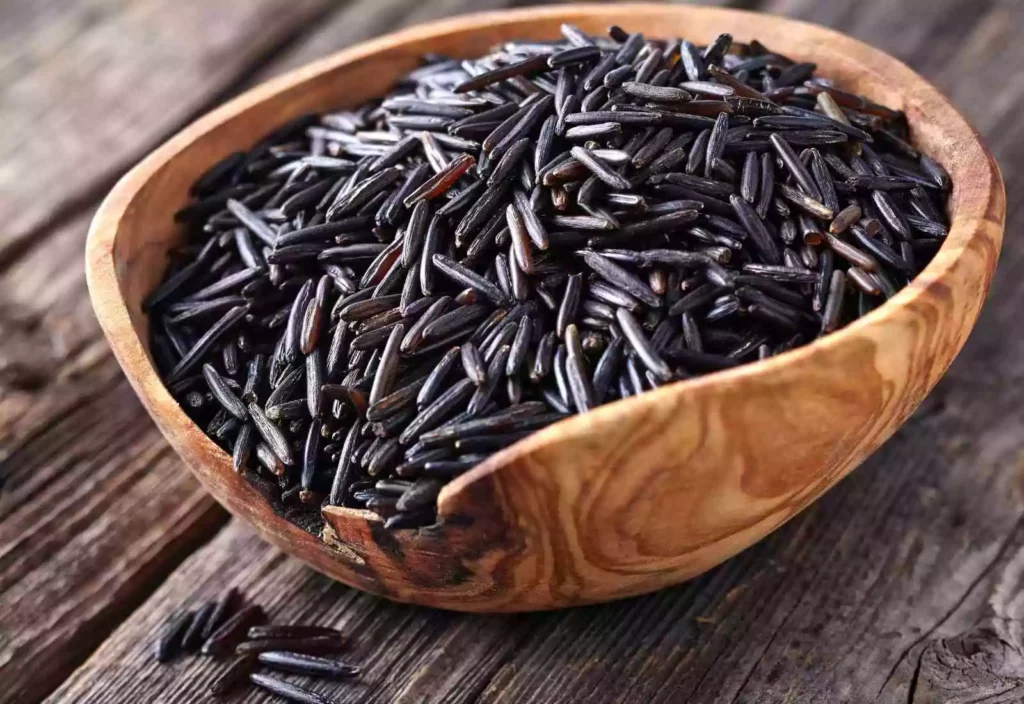In this most detailed guide, I’ll compare 2 rice types, black rice, and wild rice, for their taste, texture, cooking methods, price, and healthiness (above all). This comparison will help you better choose between black rice and wild rice.
Key Takeaways
- Black rice and wild rice are both nutritious and gluten-free grains.
- Black rice has a slightly sticky texture and a nutty flavor, whereas wild rice has a chewy texture and a nutty, earthy flavor.
- Black rice is a good source of antioxidants, including anthocyanins, which are linked to several health benefits.
- Wild rice is a good source of fiber and protein.
- Black rice is more affordable than wild rice.
- Black rice makes a better choice.
Wild Rice vs. Black Rice: A Quick Comparison
| Criteria | Wild Rice | Black Rice |
| Scientific Name | Oryza sativa | Zizania |
| Origin | Native to North America, mainly in the Great Lakes | Originated in China, but has also grown in other countries |
| Grain Appearance | Long, slender grains | Medium to short grains |
| Color | Dark brown to black | Deep purple to black |
| Texture | Chewy | Chewy and slightly sticky |
| Nutritional Content | High in protein, fiber, and antioxidants | High in antioxidants, fiber, and essential minerals |
| Gluten-Free | Yes | Yes |
| Cooking Time | Up to 1 hour | 30-40 minutes |
| Flavor Profile | Earthy, nutty flavor similar to rice | A nutty flavor with a hint of sweetness, similar to brown rice |
| Culinary Uses | Salads, side dishes, stuffing, pilafs | Desserts, rice bowls, sushi, salads, and side dishes |
| Health Benefits | Rich in antioxidants, vitamins, and minerals | Supports heart health, aids digestion, and controls blood sugar levels |
| Availability | Widely available in supermarkets | Available in specialty stores or online |
| Price | Usually more expensive than other rice types | Moderately priced, but can be more expensive in specialty varieties |
Black Rice vs. Wild Rice: What’s the Primary Difference?
Let’s begin by knowing and comparing black rice and wild rice, in general.
What is Black Rice?

Black rice is a low GI, special type of rice with a deep black (purple-black) color, which turns purple when cooked. It’s also called forbidden rice or purple rice. It got the name “forbidden rice” because only the Chinese emperor and royal family could eat it in the past. This rice was rare and had great nutritional value.
Black rice is mainly grown in Asia, particularly in China, India, and Indonesia. It has a unique nutty taste and a slightly chewy texture.
The rice’s dark color comes from anthocyanin, also found in other purple or dark foods like blueberries and blackberries. The presence of anthocyanin gives black rice its unique nutritional value and associated health benefits.
In cooking, black rice can be used in various dishes like salads, stir-fries, and desserts. Even after cooking, it retains its dark color, which adds visual appeal to meals.
What is Wild Rice?

Wild rice, not actually a type of rice, but the seed of a grass species called Zizania, is a low GI food. It’s native to North America and is commonly found in regions with freshwater lakes, rivers, and marshes.
Unlike regular rice, wild rice has a long, leaner grain. It has a dark brown or black external layer. When cooked, the grains become tender, with a slightly chewy texture. It has a rich, nutty flavor that sets it apart from other grains.
Wild rice has been a major food for Native American tribes’ diets for centuries. It’s still enjoyed today for its unique flavor and nutritional benefits.
Wild rice has a long, slender grain with a dark brown or black outer layer. When cooked, the grains become tender, with a slightly chewy texture. It has a rich, nutty flavor that sets it apart from other grains.
Wild rice is also a nutritious and antioxidant-rich food. It’s often used in salads, side dishes, soups, and stuffing.
Black Rice vs. Wild Rice: Taste and Texture
They might seem similar, yet black and wild rice differ in taste.
Black Rice
Black rice has a nutty flavor with a slightly sweet undertone. Its rich, earthy taste resembles brown rice with a more pronounced flavor. The texture is slightly chewy, adding to the overall eating experience.
Wild Rice
Wild rice offers a distinct and rich flavor profile that can be described as smoky, nutty, and sometimes similar to roasted nuts or popcorn. Its taste is more pronounced and intricate than conventional white or brown rice.
Wild rice maintains a firm and chewy texture when cooked, providing a gratifying sensation while eating.
It is worth noting that despite not technically being a type of rice, wild rice still has the characteristic flavor of rice. This is why it is commonly used as a substitute for traditional rice varieties.
Black Rice vs. Wild Rice: Nutrition and Health Benefits
| Criteria | Wild Rice | Black Rice |
| Calories in 100 grams uncooked | 357 | 363 |
| Glycemic Index | 45 | 42-45 |
| Carbs | 74.9 grams in 100 grams uncooked | 78 grams carbs in 100 grams uncooked |
| Protein | 14.7 grams in 100 grams uncooked | 8.5 grams in 100 grams of uncooked rice |
| Sodium | 7 mg | 2 mg |
| Potassium | 427 mg | 190 mg |
| Calcium | 2.1% of Daily Value | 0% of Daily Value |
| Iron | 10.6 % of Daily Value | 8 % of Daily Value |
| Dietary Fibers | 6.2 grams | 4.5 to 5 grams |
| Fat | 1.1 grams | 3.1 grams |
| Manganese in 100 grams of cooked | 0.28 mg (7% DV) | 1.2 mg (28% DV) |
| Phosphorus in 100 grams of cooked | 80 mg (14% of the DV) | 65 mg (11% DV) |
| Zinc | 1.3 mg (11% of the DV) | 1 mg (10% DV) |
| Vitamin E | 0.5 mg (5% of the DV) | 1.5 mg (15% of the DV) |
| Antioxidants | Alpha-lipoic acid | 10x more Anthocyanins than white rice |
| Flavonoids | Flavonoids | |
| Tocopherols | Carotenoids | |
| Health Benefits | Rich in antioxidants, vitamins, and minerals | Supports heart health, aids digestion, and controls blood sugar levels |
Comparing the Antioxidant Profile of Wild Rice vs. Black Rice
Black rice and wild rice share almost the same calories, GI rating, carbs content, and other nutrient ratios like magnesium, phosphorus, zinc, and manganese. Therefore, for the associated health benefits, both are alike.
The difference occurs when you compare them for their antioxidant profile.
What are similar antioxidants found in black rice and wild rice?
Both wild and black rice have flavonoids (powerful antioxidants) and manganese.
Flavonoids
Flavonoids have been studied extensively for their potential health benefits, like:
- They effectively lower the risks of developing chronic conditions such as heart disease, cancer, and neurodegenerative disorders by reducing free radicals’ stress on cells.
- Flavonoids possess anti-inflammatory effects, beneficial for avoiding and copping chronic diseases and conditions like cardiovascular disease and certain cancers.
- They improve cardiovascular health insurance by enhancing blood flow, reducing blood pressure, and inhibiting LDL cholesterol oxidation.
- Flavonoids also prevent cancer by inhibiting tumor growth and new blood vessel formation.
- They protect the brain, reduce the risk of Alzheimer’s and Parkinson’s, and improve cognitive function.
- Flavonoids support the immune system.
- They lower the risk of type 2 diabetes and improve insulin sensitivity.
Manganese
Manganese is an essential trace mineral with various health benefits.
- It is an antioxidant, protects cells from damage, and reduces inflammation.
- It contributes to bone health, collagen synthesis, and nutrient metabolism.
- Manganese helps regulate blood sugar, supports cognitive function, and aids in wound healing.
- It also plays a role in thyroid function.
However, excessive intake of manganese-rich foods can be harmful. It is obtained through a balanced diet. Please consult a healthcare professional is advised for personalized advice.
What are other antioxidants found in wild rice?
Wild rice is a rich source of other 2 types of antioxidants, which have been listed below:
Alpha-lipoic acid
Alpha-lipoic acid (ALA) is an antioxidant that safeguards cells against harm caused by free radicals. In addition to its antioxidant characteristics, ALA has demonstrated various other advantageous effects on health, such as:
- Improves insulin secretion, regulation, and sensitivity
- It may help in controlling high-fat obesity-related cardiac diseases by reducing inflammation.
- Protects against nerve damage caused by diseases like diabetes and other conditions.
- ALA can help boost the immune system to help your body fight off infection.
- Improve skin health by protecting the skin from damage caused by the sun and other environmental factors.
Tocopherol
Tocopherol, also known as vitamin E, is a fat-soluble vitamin that plays an important role in many bodily functions and overall well-being in the following ways. For example,
- Tocopherol may lessen the risk of many cancers like lung, prostate, and breast cancer.
- Tocopherol also aids in lowering cholesterol levels and improving blood pressure.
- It protects against age-related macular decay, a cause of adult vision impairment.
- It also boosts the immune system.
- Tocopherol protects skin health from sun damage and other environmental factors.
It’s noticeable that, unlike popular belief, Vitamin E has been studied to show no significant effect on lowering the mortality rate or preventing premature death. Instead, its higher dose supplementation has increased the death risk.
What are other antioxidants found in black rice?
Anthocyanins (27.2–3276 µg/g)
Anthocyanins are a type of flavonoid found in many foods, including black rice. They’re responsible for these foods’ deep purple, blue, and red colors. Anthocyanins have been shown to have several health benefits, including:
- It has anti-inflammatory properties to fight chronic inflammation, a major risk factor for fatal conditions.
- It has proven effective against obesity and insulin sensitivity.
- Anthocyanins contribute to lowering blood pressure and improving blood flow, ensuring better heart health.
- These compounds combat free radicals and inhibit the spread of cancer cells.
- Anthocyanins decrease the risk of elderly macular degeneration, the primary cause of age-related blindness. They may even improve night vision.
- They boost the immune system, which fights off infections and reduces the severity of allergic reactions and chronic diseases.
Carotenoids
They’re a group of natural pigments that give foods their bright colors. They’re antioxidants.
Here are some of the health benefits of carotenoids:
- Carotenoids may lower the risk of some cancers, including breast cancer.
- Carotenoids have effectively reduced the risk of heart disease.
- They protect against age-related vision degeneration caused by free radicals.
- Boost the immune system to help fight off infections, allergies, and chronic diseases.
- Protects skin from the sun and other environmental damage.
Thus, the intake of carotenoid-rich food reduces the risk of premature death from all causes.
Wild Rice vs. Black Rice: Other Common Health Benefits
Both black rice and wild rice offer several nutritional benefits, but some are similar because both rice types are good sources of manganese, magnesium, phosphorus, and zinc.
Here’s a breakdown of their health benefits:
High in fiber
Black and wild, both types of rice, are excellent sources of dietary fiber. Fiber promotes healthy digestion, aids in weight management, and helps prevent constipation. It also contributes to a decreasing heart disease risk and can help manage blood glucose levels.
Low glycemic index
Both types of rice have a low glycemic index (GI), meaning they have a slower impact on blood sugar levels than refined grains. This makes them suitable for individuals managing diabetes or those looking to stabilize their blood glucose.
It may help in weight loss.
Besides high fiber content, the low-calorie density of black rice and wild rice can promote satiety, helping to control appetite and support healthy weight management goals.
Heart health benefits
Black rice, and wild rice contains compounds that are beneficial for the heart. They have been found helpful for lowering LDL (bad) cholesterol levels, reducing inflammation, and supporting healthy blood pressure levels, all of which contribute to a healthier cardiovascular system.
Both black rice and wild rice offer a delightful departure from the milder taste of white rice.
Black Rice vs. Wild Rice: Allergies
Black rice and wild rice are both gluten-free and non-allergenic grains. However, some people with allergies to other grains, such as wheat or barley, may also be allergic to black rice or wild rice. So, if you’re intolerant to some foods, please talk to your doctor before trying black rice or wild rice.
Black Rice vs. Wild Rice: Cooking Method
Both black rice and wild rice require specific cooking methods to achieve their optimal texture and flavor. Here’s a comparison of the cooking methods for black rice and wild rice:
Black Rice
- Rinse black rice thoroughly before cooking under cold water to remove any impurities or excess starch.
- Soak rice in cold water and leave it in the refrigerator overnight. It’ll help in getting soft rice when cooked.
- Use 2 cups of water for 1 cup of black rice.
- Cook black rice on the stovetop or use a rice cooker for 30-40 minutes by simmering them on low flame.
- When there is little water left, reduce the flame to the minimum possible and let the rice cook covered until all water has dried.
- After cooking, let the black rice rest for about 5-10 minutes to allow for additional moisture absorption and further softening.
- Gently fluff the cooked black rice with a fork before serving.
Remember to follow the instructions on the packaging or refer to a specific recipe for precise cooking times.
Wild Rice
- Rinse wild rice under cold water to remove any debris or impurities.
- Soak wild rice for 6 hours or overnight in the refrigerator to reduce the cooking time and soften the grains.
- Drain the soaking water before cooking.
- Use a ratio of 3 cups of water for 1 cup of wild rice.
- Cook wild rice on the stovetop or using a rice cooker. It typically takes around 45-60 minutes to cook. However, cooking times may vary depending on the specific variety and desired tenderness. Adjust the cooking time accordingly.
- When the water is dried, let the wild rice sit covered for about 5-10 minutes to allow the grains to absorb any remaining moisture.
- Gently fluff the cooked wild rice with a fork before serving.
Note
The cooking times provided are general guidelines. So, it’s essential to follow the instructions on the specific packaging or refer to a trusted recipe for more precise cooking instructions.
By following the appropriate cooking methods, you can achieve properly cooked and flavorful black rice or wild rice for your desired culinary creations.
Which is Expensive, Wild Rice or Black Rice?
Wild rice is more expensive than black rice. They cost you about $10 to 15 per pound*. On the other hand, black rice costs about $5-7 per pound*. (*Sponsored links)
The higher cost of wild rice can be attributed to its limited availability, specific growing conditions, and the perception of it being a specialty or gourmet ingredient. However, the price of wild and black rice can vary depending on the brand, region, and market conditions.
Final Thoughts on Black Rice vs. Wild Rice: Which is Better for You?
Black rice is a better choice over wild rice for the following reasons:
- Nutrients like zinc, manganese, magnesium, and phosphorus are found in higher amounts in black rice.
- Black rice also has anthocyanins as antioxidants, associated with various health benefits, including reduced inflammation, cancer risk, and improved heart health.
- Black rice is also a good source of fiber, minerals, and vitamins, such as iron and vitamin E.
- Also, it’s cheaper than wild rice.
So, you can opt for black rice for the price and overall value.
FAQs
Is Black Rice Sticky?
Black rice has a slightly sticky texture when cooked, similar to other sticky or glutinous rice types.
Is Wild Rice Sticky?
Wild rice (technically rice), but a type of aquatic grass, has a chewy texture when cooked and does not become sticky like some rice varieties. It keeps its individual grains and does not clump together like sticky or glutinous rice.
Why is My Wild Rice Sticky?
Possible reasons for sticky wild rice include using too much water, overcooking, not rinsing the rice before cooking, or using a variety of wild rice with a naturally sticky texture.
Is Wild Rice Glutinous?
No, wild rice is not glutinous. Glutinous rice (sticky rice) is a different rice type that contains a higher amount of amylopectin, a type of starch that gives it its sticky texture when cooked. Wild rice has a different composition and does not possess the same sticky properties as glutinous rice.







